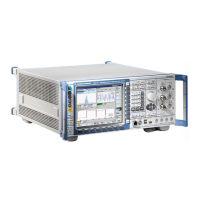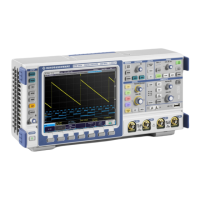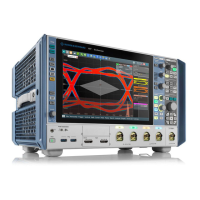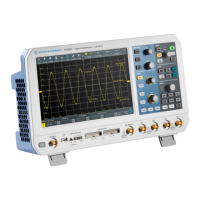Instrument Design and Function Description CMU
1100.4903.82 3.6 E-4
POWER SUPPLY
The POWER SUPPLY of the CMU consists of a two-part aluminum casing with three boards arranged
in a so-called sandwich technique (U-shape). In addition to cooling, the axial fan already mentioned
above (see cooling of instrument) is also used to support the three boards.
STANDBY/ON signal
The control signal STANDBY/ON controlled by the FRONT MODULE
CONTROLLER (depending on the operating key STANDBY/ON on the
front of the instrument frame) activates the power supply.
Power Factor Correction
(PFC) and Standby circuit
The POWER SUPPLY is a primary clocked switching power supply
with Power Factor Correction (PFC) and Standby circuit (+12 V
Standby).
On the secondary side, it generates all DC voltages (+3.3 V; +5.2 V;
+6 V; +8 V; +12 V; +12 VFAN; +12 V Standby; +28 V; -12 V) for the
CMU.
The secondary voltages are open-circuit-proof and short-circuit-proof
with respect to ground and each other.
POWERGOOD - Signal
When switching on and off (defined reset), the POWER SUPPLY
generates a POWERGOOD signal for control of the FRONT MODULE
CONTROLLER.
Overtemperature
protection
An overtemperature protective circuit is additionally installed to prevent
overheating. This status is taken to the FRONT MODULE
CONTROLLER via a status signal (OT).
AC voltage supply
A 3-pin connector with integrated 2-pin mains switch for connection
with the AC-Supply is installed on the rear panel of the POWER
SUPPLY. From there, the AC supply voltage is internally taken to the
first board via two cables.
Two fuses are also fitted there as a means of fire protection.
Note: These fuses are not accessible to the user from outside and
are only blown in the case of a serious fault of the power
supply (servicing required!).
Primary side
The following circuit parts follow on the first board: EMI filter and power
rectifier. The rectified AC supply voltage is taken via a cable to the
second board of the Power Factor Correction (PFC). This circuit
converts the rectified AC supply voltage up to a constant voltage of
380 VDC. Then this voltage is taken to a step down converter which
provides a constant voltage of 280 VDC for the subsequent resonance
step down converter, which chops it with approx. 35 kHz.
An additional connecting cable is used to feed the big transformer
located on the first board. It is provided with taps for the various
secondary voltages, and the following rectifiers constitute the transition
to the DC secondary side.
Secondary side
The +12 V-, -12 V- and +6 V- secondary voltages are provided with
analog regulators in order to ensure a high spurious suppression.
The +3.3 V- and +5.2 V- secondary voltages have their own stepdown
converters to achieve small power dissipations.
The +28 V- voltage requires a stepup converter in order to generate
the high voltage with a high accuracy.
At the +12 VFAN, a constant current source is used for efficient
suppression of fan interference.
The secondary voltages are then filtered and subsequently taken to the
output connector.

